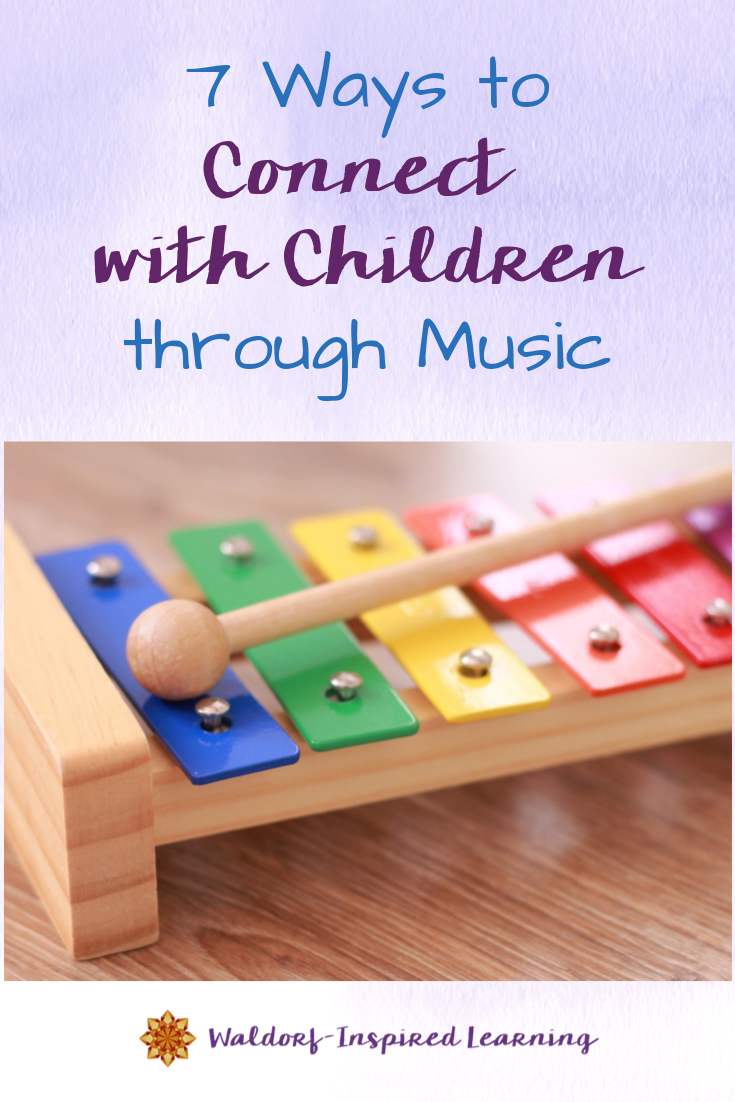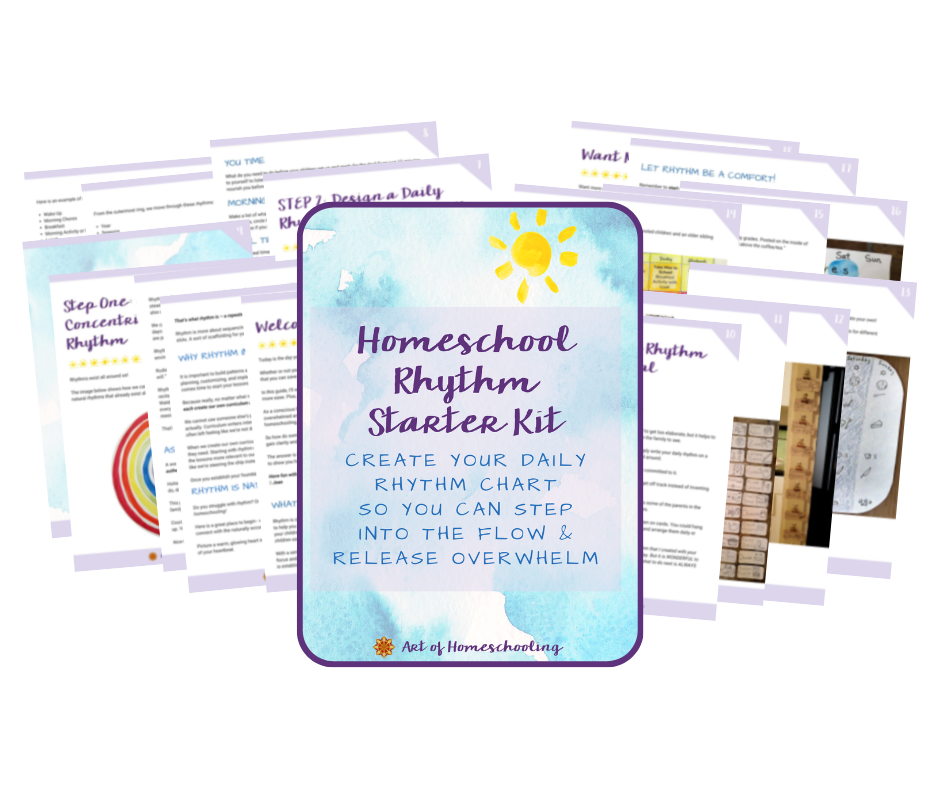I have always loved going to classical and contemporary music concerts with my children. When I learned that the founder of Waldorf education, Rudolf Steiner, said both poetry and music help to bring us together as a community, I was thrilled because I treasure both. And I know that in homeschooling, our family is the community! Today, I want to share with you seven ways to connect with children through music to help you strengthen those family bonds.

This post is sponsored by Music Ed magazine. All opinions expressed are my own. Read my full disclosure policy here.
Connect with Children through Music
Sing Throughout Your Day
Even if you feel like you’re off key! Sing as you wash dishes, as you cook or tidy the house, to call children to lessons. Singing allows us to connect – through eye contact, a shared activity, blending our voices. Because it’s the act of singing not the quality that counts.
Singing is great for children starting from birth and for as long as you can keep this going! Up to age 10 or 12, even through their teen years if you can! Learn the songs by heart and by ear and your children will follow suit.
In the younger years, we can sing simple songs from nursery rhymes and seasonal tunes. We can also introduce folk songs that often bring in history and culture.
Add in Movement
Crossing the mid-line refers to movement that in which the arms or legs cross over to the opposite side. This kind of movement helps to myelinate the brain, meaning it helps the right and left hemispheres of the brain connect to each other, a necessary prerequisite to learning to read.
In other words, movement activities (which are more fun with music!) help with all kinds of brain development that contribute to learning all kinds of skills from reading to math tasks.
Introduce Children to an Instrument
In the Waldorf approach, Steiner suggested the first instrument be a blowing instrument introduced at around age six or seven – something like a recorder or penny whistle or wooden flute to help. These instruments help regulate the child’s breathing.
After a few years of a simple blowing instrument, children are ready for the next stage which is often a string instrument.
Learn an Instrument Yourself!
If you’ve always wanted to learn to play an instrument, now’s your time. Just for your own enjoyment. Because your children will take note. You can learn music at any age and improve your skills.
Make Music as a Family
Learn the same tune or song on multiple instruments – sing it, play it on recorder, play it on piano, learn it on guitar or ukulele. Then play together!
Make music as a family! Have Friday night sing-alongs. These can be so much fun, full of joy and laughter. A great bonding activity. Keep it playful and fun. No pressure, just a collaborative group activity. That way, anyone can join in whether they play an instrument or just want to sing along.
Go Hear Live Music
Our orchestra here in town (the fabulous Cleveland Orchestra) has education concerts for school groups. We went every year in a group of homeschoolers to these student matinees (for great prices!). We heard such beautiful classical music LIVE!
Aside from listening to the performances, I loved receiving recordings of the musical pieces and a student magazine ahead of the concert. The magazines were full of fun articles on the music, the historical period, and the composers.
We are also blessed here in Cleveland with the Contemporary Youth Orchestra, a group of talented teens who play together and perform three or four concerts a year. It’s so great for our children to see teenagers working hard together to perform music on stage.
Study a Composer
This is a great mixed-ages learning activity for your homeschool. Choose a composer and find a few books on him/her at the library. Do a little reading and a little listening. This is a wonderful way to integrate history, biography, and music all into one lesson.
Music Ed Magazine Helps You Connect through Music
Looking for more ideas to keep your children musically active?
Check out Music Ed magazine, a digital magazine that’s great for homeschoolers. It’s free! Each quarterly edition is full of inspiration, encouragement, and support for you and your children.
To sign up for your FREE subscription, visit Music Ed magazine.
Music Ed magazine is packed with free printable resources and fun activities for kids. It’s a tool for music teachers and parents to encourage kids and families to be musically active. Whether your child is taking music lessons with a private teacher or you are teaching your child yourself, you’ll find inspiration, practical guidance, and free music teaching resources and activities.
In the latest edition, Fall 2019, you’ll find “Tips to Engage Your Children at a Concert” along with a great article offering “Solutions to the Practice Problem.” Includes great book recommendations and fun activity pages, too.
Sneak peak: the winter issue coming out in January has an article just for homeschoolers! I’m really looking forward to reading, “6 Components of a Balanced Homeschool Music Curriculum.“
Sign up here for free: Music Ed Magazine.
Above all, find ways to connect with your children through music! Sing, make music together, and savor those connections.





Hi Jean
I know Steiner encouraged wind instruments to start with e.g. recorder…I play and teach guitar andharmonica esp. blues harp to beginners. It involves breathing in and out ,sometimes quickly and requires strong embourche….Mostly folk music: blues and celtic….Do you think it’s more appropiate for older kids? I had one music prodigy who played several instruments and he was around 9y.o. when he started…..Do you think 6-7-8 grades are too young? I was thinking of approaching my local school about a class.Richmond (VA) Waldorf School.
Thanks for your thoughts! Mike Bogil
Great question, Mike! Steiner suggested the simple wind instrument for starting around age 6 or in first grade. By age 9, children are encouraged to take up a string instrument. So for sure grades 6-7-8 is not too young! Maybe even starting in grades 4 or 5. Different schools and teachers have differing opinions on this but for sure, I’d encourage you to approach the local Waldorf school about possibilities. I’d love to know what they say. And don’t forget about homeschoolers! You might offer a class for a local homeschoolers as well. 🙂